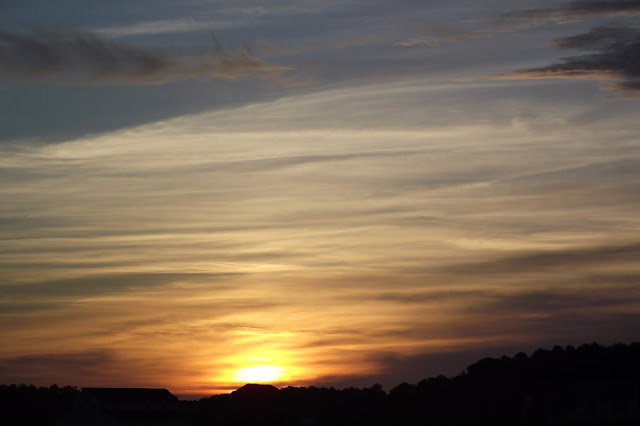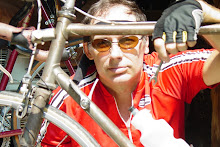Kayaking Taylor's Island Estuary
June 22nd, 2013
Some families on the Bay live in
modest bungalows with a nice view of the water. Others reside in
spacious and elegant towers, with plenty of furniture and the latest
communication equipment.
One hot afternoon a cruising catamaran
dropped anchor near a low highway bridge, its further progress
blocked. Three hard-bitten, grizzled specimens emerged into the
burning sunlight, and launched a rubber raft, towing three kayaks
under the bridge and into the trackless wetlands that form an
ever-shifting maze in one small part of the brackish waters of the
Chesapeake. They were all seasoned veterans of the endless struggle
that is the essence of being male. Married men.
After a false start or two, down blind
alleys and into narrow leads between the stiff brush walls, they
regroup and tow farther east into more complex and open waters.
Breezes are slight and erratic, and the tide, near its height,
carries them onward. They tie the raft to a stick in an open
location, hoping it will be there when they return.
An early design effort by Ludwig Mies
van der Rohe, after his duck-hunting buddies complained that their
blinds were always little more than a heap of sticks with a few
tired, hackneyed Neoclassical elements tacked on, which no longer
fooled the ducks because of the sense of alienation or distance from
the landscape itself.
The sheaves surrounding this stunning
presentation by Le Corbusier (who felt impelled to get into the game
or be left in the mud) were criticized by Mies as an effete reference
or homage to the goddess Demeter, detracting from the pure expression
of space by the structure itself. Reportedly, when Le Corbusier
heard of this he just squinted, turned his head to spit his tobacco
juice into the bay, and grunted, “Bullshit.” In this way are the
priceless native customs and morays diffused into new populations. No
– not eels.
This iconic glass brick by which we
all so fondly remember Mies, has, tucked away on the roof, a
faux-straw-and-plywood duck blind (mainly constructed of stainless
steel) as a tribute to his humble beginnings. Legend has it that he
used, in his later years, to sit for hours up there at dawn with a
shotgun, waiting for the ducks that would never come.
This magnificent duck-blind sculpture
by Philip Johnson represents a peak in the art. It has a boat-stall
capable of hiding a sixteen-foot skiff, and enough room in the blind
for six hunters and all the beer that that entails. Negotiations
into the middle seven figures with MOMA and competing European
museums to purchase the structure and move it to an indoor artificial
wetland complete with mallards, have run aground and stuck fast in the mud of
international high-art politics. Notice if you will, the superbly casual irregularity of the rectangular panels. The result of exacting calculation or the simple brilliance of sheer laziness?
A side view, showing the spare yet
lush natural landscaping.
van der Rohe's Farnsworth House, built
on a flood plain and clearly influenced by duck-blind principles. We
may judge its success by the Wiki blather as follows:
“The highly-crafted pristine white
structural frame and all-glass walls define a simple rectilinear
interior space, allowing nature and light to envelop the interior
space. A wood-panelled fireplace (also housing mechanical equipment,
kitchen, and toilets) is positioned within the open space to suggest
living, dining and sleeping spaces without using walls. No partitions
touch the surrounding all-glass enclosure. Without solid exterior
walls, full-height draperies on a perimeter track allow freedom to
provide full or partial privacy when and where desired. The house has
been described as sublime, a temple hovering between heaven and
earth, a poem, a work of art.
The Farnsworth House and its 60-acre wooded site was purchased at
auction for US$7.5 million by preservation groups in 2004 and is now
owned and operated by the National Trust for Historic Preservation as a public museum.”I've heard it's hell to heat and cool – but who the hell cares – it's art. What's that you say? It looks like some old iron trusswork found abandoned out behind the rail yard, painted white?
A latecomer to the scene, Frank L.
Wright, professed to be saddened by all the squabbling around the
duck-blind aesthetics, and put up this beautifully spare and gaunt
framework, allegedly to restore the art to its roots in pure
Euclidean geometry, and inject some honesty and forthrightness into
the scene. Of course he was immediately savaged and ridiculed, the
others saying that he had simply stopped work and left when he
realized that he didn't know one end of a shotgun from the other, and
disliked the bitter beers so popular in the marsh. Also he kept
bending nails and hitting his thumb.
The periwinkles cling to their arcane
geometries. They stubbornly refuse to entertain any notion of
rationalist, rectilinear architecture, and they openly sneer at the
theories of Walter Gropius and all his intellectual and aesthetic spawn.
Returning, we saw a huge pile of
sticks high in a pine tree, and shortly thereafter saw a huge old
bald eagle perched a hundred yards away; soon it flew. Not long
after we saw another one; my impression was that it was smaller and
younger. It dived once or twice and then soared up in larger and
larger circles, widening its search field high into the bright, clear
sky. We drifted on our boats, letting the paddles drip; time seemed
to flow slower and slower; the afternoon approaching a still point,
when the everlasting pendulum of life seems to rest in balance, and
in that moment opening the illusion of eternity. One forgot just for
a while the ridiculous sight seen earlier: a small biplane
put-putting across the sky in the distance like an idling lawnmower;
in the binoculars it was seen to be purple.
"During the Middle Ages the communal clock extended by the bell permitted high coordination of the energies of small communities. In the Renaissance the clock combined with the uniform respectability of the new typography to extend the power of social organization almost to a national scale. By the nineteenth century it had provided a technology of cohesion that was inseparable from industry and transport, enabling an entire metropolis to act almost as an automaton. Now in the electric age of decentralized power and information we begin to chafe under the uniformity of clock-time. In this age of space-time we seek multiplicity, rather than repeatability, of rhythms. This is the difference between marching soldiers and ballet."
- Marshall McLuhan, Understanding Media: the Extensions of Man, 2nd. ed. chapter 15. 1964.
So that's why we're out here in these boats, goofing off for all we're worth.
Almost everything seems funny to this
simpleton.
East of the sun;
West of the moon.
And the great eyelid of the day slowly
closing.
Returning across the bay the next morning in mediocre winds, we
watched a front come in, and rain, but without any violence or drama,
except visually. Then for a while all we could see in any direction
was a hundred yards of rain. I snoozed on the dining room bench, the
boat rocking gently through the quiet rain.





















